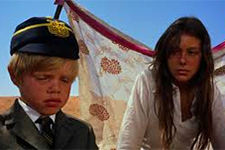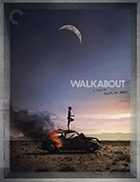Walkabout (4K UHD)
|  For many years—27 years, to be precise—Nicolas Roeg’s Walkabout, an intensely felt film about the conflicts between civilization and nature and the tragedy that can result when people are unable to communicate, was a kind of lost film. Although it had been released theatrically in 1971 to widespread critical acclaim and had helped solidify Roeg’s stature as one of the most important and innovative of the new British directors, the film languished for nearly three decades with no home video release. Thankfully, in the late 1990s it was finally released on video, laserdisc, and DVD so that a new generation could discover it, and seeing it again many years later only confirms my initial impressions: Beautiful, striking, and heartfelt, it is a truly great film that speaks across generations despite its clear grounding in a particular cinematic era. The script by British playwright Edward Bond, who had previously written the English language dialogue for Michelangelo Antonioni’s Blowup (1966), is a relatively loose adaptation of a 1959 adventure novel originally titled The Children by James Vance Marshall, a pseudonym (confusingly derived from an actual Australian writer and adventurer) for the British novelist Donald Gordon Payne. Unlike the book, which opens with two children stranded in the Australian outback after a plane crash, the film opens in the city, where Roeg quickly and effectively establishes the repetitive drone of modern society, with its brick walls and tall skyscrapers and impersonal movement. We are introduced to the eventual protagonists, a teenage girl (Jenny Agutter) and her 7-year-old brother (Luc Roeg, the director’s son), who live in the city and are very much a product of it. In his typically elliptical narrative fashion, Roeg wordlessly moves the story to the flat plains of the outback, where the kids’ father (John Meillon) takes them for a picnic, although his cool demeanor toward them and their lack of affection toward him suggests that something is deeply wrong. In an unexplained fit of manic depression, the father attempts to kill them, then sets their car on fire and shoots himself. Stranded with little food and water and no means of transportation and no idea where they are, the two kids set off in an attempt to find their way back through the wilderness, with the girl trying to shield her younger brother from the horrors of what has just happened (she acts like it’s all a game and the father will meet them later). Of course, life in the city has left them ill equipped to survive without modern conveniences; like the children in William Golding’s Lord of the Flies, they are symbols of refined British culture cut adrift from the world of manners and rituals, although unlike Golding’s characters, they do not descend into savagery (the girl, in particular, is constantly concerned with their physical presentation, which comes only a short second to finding sustenance). Roeg, who began his career as a cinematographer and produced some of the most intriguing genre deconstructions of the 1970s, including the horror melodrama Don’t Look Now (1973) and science fiction parable The Man Who Fell to Earth (1976), does a marvelous job of turning the Australian outback into a character all its own (he both directed and acted as his own cinematographer here). His documentary-like camera constantly roams the wilderness, finding life in all its nooks and crannies. Despite the imminent threat the wilderness poses to the children, we realize that the outback is not a desolate place of death, but rather a wonderful environment teeming with life and vitality. Lizards crawl underfoot, birds perch in the limbs overhead, snakes slither among the rocks, kangaroos hop through the trees. Sustainable life is there if one knows how to use it to their advantage, but unfortunately, these two city kids have no clue. Several days later, when they are on the brink of dehydration, the kids find—or rather, are found by—an Aboriginal boy (David Gulpilil) who is on a “walkabout,” a tribal rite of passage where boys on the verge of manhood go off into the wilderness alone for an extended period of time to live off the land. When they first meet, the two cultures stare at each other strangely, the city kids’ sunburned white skin looking as strange to the Aborigine as his blue-black skin looks to them. After showing the kids how to get water out of the ground, the Aborigine takes them along with him. The rest of the film follows them through the outback, showing in great detail how the Aborigine is able to survive where the kids could not. He can hunt, make weapons, find water, and beat the incessant heat. Many of these scenes are intercut with nondiegetic inserts of “civilization,” showing how the two ways of life are disparate, and yet the same. In one instance, Roeg cuts between the Aborigine cutting up a kangaroo he has killed and scenes of a butcher hacking up meat on a cutting block. They are the same, but different, which creates a crucial undercurrent of human solidarity that is too often ignored as we divide ourselves into races and sects and cultures and parties. The girl and her brother begin to form a bond with the Aborigine, but it is a strange relationship of broken communication. The little boy, perhaps because of his age and naiveté, is more willing to communicate with and try to understand the Aborigine, while the girl is more interested in using him to get back to civilization. Because they are virtually the only characters on-screen for most of the film, the three central performances are crucial. Agutter radiates intelligence and patience, but with just a touch of prudence and good British reticence that reminds us that she is a product of a particular culture. As the Aboriginal boy, Gulpilil never utters a word we understand except once when he repeats the word “water.” He is an incredibly physical actor, with wonderful facial expressions that convey all we need to know. Throughout the film we are able to watch his eyes as he develops emotions and longings for the white girl that she does not or cannot understand. The girl still clings to her English civility, while her younger brother wants to immerse himself in nature like the Aborigine (when his sister tells him to put his shirt back on, his immediate reply is that the Aborigine boy isn’t wearing one). However, the girl does find herself drawn to the natural world, particularly in a sequence in which shots of her swimming naked in a rock lake are intercut with shots of a group of Aborigines (the boy’s tribe, perhaps?) exploring the charred remains of her father’s car. It presents a fascinating juxtaposition, with the city girl shedding the outer vestiges of civilization and embracing the natural world while the natives ultimately reject the charred remains of the civilization that threatens to engulf them (this sequence connects back to Roeg’s curious use of a tracking shot along a brick wall early in the film that connects the city with the outback, suggesting that the former is encroaching on the latter). Walkabout thus gives us competing portraits of the outback—beautiful and harsh, sensual and dangerous, full of life and full of death—that are crucial to its emotional and visual complexity. While grounded in harsh realism, parts of the film are elevated to near surrealism, giving the struggle between civilization and nature a deep, poetic resonance. Even the film’s dated camera techniques—grainy freeze-frames, reverse motion, nondiegetic inserts, and extended zooms—enhance, rather than detract from, its elegance and lyricism. With today’s glut of highly politicized environmentalism, in which there is as much at stake in money and power as there is in protecting plants and wildlife, Walkabout is bracing in the way it truly celebrates life in all its many forms.
Copyright © 2023 James Kendrick Thoughts? E-mail James Kendrick All images copyright © The Criterion Collection | |||||||||||||||||||||||||||||
Overall Rating: 


 (4)
(4)


